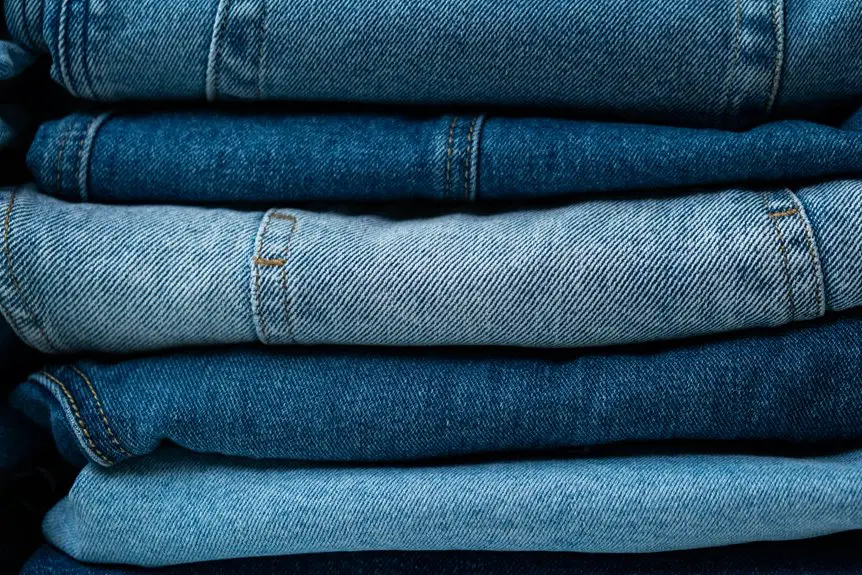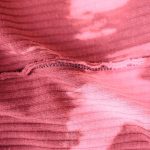Setting dye in fabric is essential for vibrant, long-lasting colors. Start with heat setting using a dryer or iron to bond the dye, or soak the fabric in vinegar and water for added colorfastness. Rinse your items in cold water to remove excess dye and wash them separately in mild detergent. To maintain color, air dry instead of using a dryer and store fabrics in shaded areas. Discover more tips and techniques to perfect your dyeing projects.
Table of Contents
Key Takeaways
- Use heat setting methods like a dryer or iron to bond dye with fabric fibers for long-lasting color.
- Soak dyed fabric in a vinegar and water solution to enhance colorfastness and prevent fading.
- Rinse dyed items in cold water until the water runs clear to remove excess dye.
- Wash dyed fabrics in cold water with mild detergent and air dry to maintain color integrity.
- Store dyed items in shaded areas and use breathable materials to protect against moisture and sunlight.
Understanding the Importance of Color Setting
When you dye fabric, understanding the importance of color setting is vital if you want your vibrant hues to last.
Color setting helps lock in those beautiful shades, preventing them from fading or bleeding during washing. Without it, you risk watching your hard work wash away, leaving you with dull, lackluster fabric.
It’s not just about the initial dyeing process; it’s about preserving the results over time. You’ll find that different fabrics react differently to dyes, which can impact how well colors set. Knowing this can save you from frustration later.
Recommended Techniques for Setting Dye
To guarantee your dyed fabric retains its vibrant colors, you can use several effective techniques for setting the dye.
One common method is heat setting, where you place the fabric in a dryer or use an iron on the appropriate setting. This helps the dye bond with the fibers.
Heat setting your dyed fabric with a dryer or iron helps ensure the dye bonds effectively with the fibers.
Another technique involves soaking the fabric in a solution of vinegar and water for 30 minutes, which can enhance colorfastness.
You might also try cold water rinsing after dyeing to remove excess dye that hasn’t bonded yet.
Finally, using a commercial dye fixative can provide added protection against fading.
Experiment with these methods to see which works best for your specific fabric and dye type, ensuring long-lasting, brilliant colors.
Essential Tools and Materials for Dye Setting
After exploring the techniques for setting dye, it’s important to gather the right tools and materials to guarantee success.
First, you’ll need a dye fixative or setting solution specific to the dye you’re using. Make sure to have a large pot or bucket for dyeing, along with stirring tools like a wooden spoon or stick.
Protective gear, such as gloves and an apron, is essential to keep your hands and clothes safe. You’ll also want measuring cups for accuracy and a timer to keep track of dyeing times.
Finally, stock up on clean rags or paper towels for any spills. With these essentials in hand, you’ll be ready to confidently set the dye in your fabric.
Common Challenges in Dye Setting and Solutions
When setting dye in fabric, you might face issues like color bleeding or uneven dyeing.
These challenges can be frustrating, but with the right techniques, you can achieve better results.
Let’s explore some practical solutions to guarantee your dyed fabrics turn out just as you envisioned.
Preventing Color Bleeding
Color bleeding can be a frustrating issue for anyone working with dyed fabric, especially if you’re aiming for vibrant, long-lasting results.
To prevent this, start by using high-quality dyes specifically designed for the fabric type. Always pre-wash your fabric to remove any finishes or residues that might cause color transfer.
After dyeing, rinse the fabric in cold water until the water runs clear, then use a color fixative to set the dye. It’s also essential to wash dyed items separately in cold water using a gentle detergent for the first few washes.
Avoid exposing your dyed fabric to direct sunlight for prolonged periods, as this can fade colors and lead to bleeding.
With these steps, you can enjoy beautiful, bleed-free fabrics.
Addressing Uneven Dyeing
Even with careful preparation, uneven dyeing can still occur, leaving you with patches or streaks that mar your project. If you notice these imperfections, don’t panic.
Start by washing the fabric in cold water to remove excess dye. After that, you might consider re-dyeing the affected areas. Use a spray bottle for more control, applying dye gradually to the uneven spots. Always test on a scrap piece first to guarantee you achieve the desired shade.
If the color is still off, blending the dye with a fabric medium can help create a more uniform look. Finally, remember to set the dye properly by following the recommended heat or chemical fixative methods to prevent future issues.
Best Practices for Maintaining Color Longevity
To keep your dyed fabrics looking vibrant, you’ll want to adopt a few best practices.
Washing them correctly, steering clear of direct sunlight, and storing them in ideal conditions can make a big difference.
Let’s explore each of these strategies to guarantee your colors stay bold and beautiful for years to come.
Proper Washing Techniques
When you wash dyed fabrics, using the right techniques can greatly extend the life of their vibrant colors.
Always wash these items in cold water to prevent color bleeding. Use a mild detergent specifically designed for colored fabrics; avoid bleach and harsh chemicals.
Turn your garments inside out before washing to minimize friction and fading. It’s best to hand wash delicate items, but if you use a machine, opt for a gentle cycle.
Avoid overloading the washer, as this can cause additional wear. Rinse thoroughly to remove all detergent residue, which can dull colors.
Finally, air dry your dyed fabrics instead of using a dryer, as heat can weaken fibers and lead to fading.
Avoiding Direct Sunlight
Since prolonged exposure to direct sunlight can cause colors to fade, it’s crucial to store and display your dyed fabrics in shaded areas.
Here are some best practices for maintaining color longevity:
- Use curtains or blinds to block sunlight in your display area.
- Opt for UV-protective glass when framing fabric art.
- Store fabrics in dark, cool places to minimize light exposure.
- Rotate items in your collection to avoid uneven fading.
- Avoid hanging dyed fabrics in windows or direct light paths.
Ideal Storage Conditions
While you want your dyed fabrics to look vibrant, storing them in ideal conditions is crucial for preserving their colors. Keep your fabrics in a cool, dry place, away from humidity and extreme temperatures.
Use breathable storage bags or cotton sheets instead of plastic, as these materials allow airflow and prevent moisture buildup. If possible, fold your fabrics neatly to avoid creasing, and store them flat to minimize stress on the fibers.
For longer-term storage, consider using acid-free tissue paper between layers to protect the dye. Regularly check your stored fabrics for any signs of fading or damage, and rotate them occasionally to guarantee even exposure to air.
Following these practices will help maintain your fabrics’ stunning colors for years to come.
Tips for Storing Dyed Fabrics Properly
Properly storing dyed fabrics is essential for maintaining their vibrant colors and overall quality. Follow these tips to keep your fabrics looking fresh and beautiful:
- Keep away from sunlight: Store fabrics in a dark place to prevent fading.
- Use breathable storage: Avoid plastic bags; opt for cotton or linen to allow air circulation.
- Fold carefully: Prevent creases and damage by folding them neatly rather than hanging.
- Avoid heavy stacking: Don’t pile too many fabrics on top of each other to prevent crushing.
- Check humidity: Store in a cool, dry area to avoid mold or mildew.
Frequently Asked Questions
Can I Use Fabric Softener After Dyeing?
You shouldn’t use fabric softener immediately after dyeing. It can interfere with the dye’s adherence to the fabric. Instead, wait a few washes to guarantee the color sets properly before adding softener.
How Can I Fix a Dye Mistake?
If you’ve turned your shirt into a rainbow disaster, don’t panic! You can try soaking it in a vinegar solution or re-dyeing it to fix that colorful catastrophe. Turn that mistake into a masterpiece!
Is It Safe to Wash Dyed Fabric With Other Clothes?
It’s best to wash dyed fabric separately initially. This way, you prevent any potential color bleeding onto your other clothes. Once you’re sure the dye’s set, you can safely wash them together.
How Long Does Dye Setting Last?
“Better safe than sorry,” you might think. Dye setting typically lasts several washes, but it depends on the dye type and fabric. Always follow care instructions to prolong the vibrancy of your dyed items.
Can I Dye Synthetic Fabrics Effectively?
Yes, you can dye synthetic fabrics effectively, but you’ll need specific dyes designed for synthetics. Choose the right dye, follow the instructions carefully, and you’ll achieve vibrant, long-lasting results on your fabric.
- Can You Tie-Dye Lyocell? Get Amazing Results With This Guide - July 14, 2025
- Is Lyocell See-Through? What to Know About Fabric Transparency - July 14, 2025
- What Is a Lyocell Comforter? The Benefits for a Better Night’s Sleep - July 14, 2025




